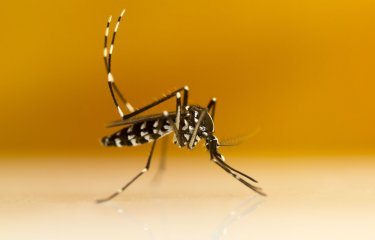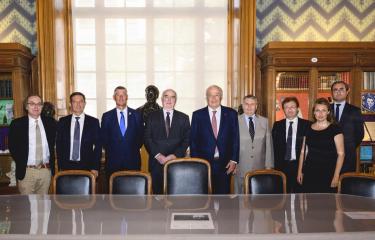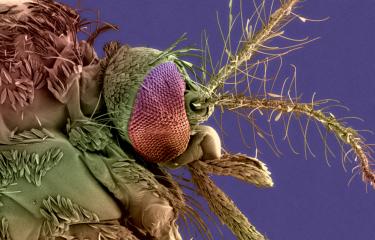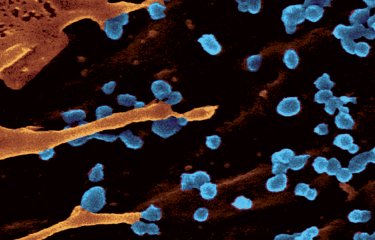Scientists from the Institut Pasteur, Inserm and CNRS, have identified a human-specific factor involved in the replication of Chikungunya virus which accounts for the species specificity of this virus. Chikungunya virus is an emerging virus that in 2005 caused, for the first time, an outbreak in La Réunion island, a French overseas district where more than 30% of the population was infected, and has recently emerged in temperate regions of Europe. The identification of this new host factor enriches our understanding of the molecular bases of Chikungunya virus infection, which were characterized so far. This work also paves the way for the development of a more relevant humanized animal model to better understand the pathophysiology of infection. This research has been published online on April 26, at the European Molecular Biology Organization reports (EMBO reports).
Press release
Paris, May 5, 2013
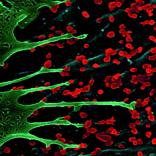
The molecular mechanisms of Chikungunya virus infection in human cells have been poorly characterized. Scientists at the Institut Pasteur, Inserm and CNRS, under the leadership of Marc Lecuit, head of the Biology of Infection Unit at the Institut Pasteur in Paris, have made a significant advance: they have identified a human-specific intracellular molecular factor called NDP52 that is involved in the replication of Chikungunya virus. The scientists have demonstrated that in human cells, NDP52 is able to bind to a protein of Chikungunya virus, nsP2, and that this interaction promotes the replication of the virus inside its target cells, thereby contributing to the development of human Chikungunya virus infection. In contrast, mouse NDP52 does not interact with nsP2, and NDP52 therefore does not promote infection in murine cells.
In 2008, the team headed by Marc Lecuit had developed the first animal model to experimentally reproduce the human disease caused by Chikungunya virus. This animal model has since allowed a better understanding of the physiopathology of infection, and has enabled the identification of Chikungunya virus target cells and tissues to test the efficacy of preventive and curative approaches. The discovery of the role of the human factor NDP52 in Chikungunya virus infection opens new avenues for the development of a humanized animal model, which would be instrumental for deeper understanding of the pathophysiology of Chikungunya virus infection.
--
Illustration – Copyright Institut Pasteur / Thérèse Couderc
Caption – Chikungunya viruses at the surface of an infected human fibroblast.
Source
Species-specific impact of the autophagy machinery on Chikungunya virus infection, European Molecular Biology Organization reports, April 26, 2013
Delphine Judith (1,7), Serge Mostowy (2,8), Mehdi Bourai (3), Nicolas Gangneux (1,7), Mickael Lelek (4,9), Marianne Lucas-Hourani (3), Nadège Cayet (5), Yves Jacob (6), Marie-Christine Prevost (5), Philippe Pierre (10,11), Frédéric Tangy (3), Christophe Zimmer (4,9), Pierre-Olivier Vidalain (3), Thérèse Couderc (1,7) & Marc Lecuit (1,7,12,13)
(1) Institut Pasteur, Biology of Infection Unit,
(2) Institut Pasteur, Bacteria-Cell Interactions Unit,
(3) Institut Pasteur, Viral Genomic and Vaccination Unit,
(4) Institut Pasteur, Computational and Imaging and Modeling Unit,
(5) Institut Pasteur, Ultrastructural Microscopy Platform,
(6) Institut Pasteur, Genetic, Papillomavirus and Human Cancer Unit,
(7) Inserm U1117, Institut Pasteur, Biology of Infection Unit,
(8) Inserm U604, INRA USC2020, Institut Pasteur, Bacteria-Cells Interactions Unit,
(9) CNRS UMR2582, Institut Pasteur, Computational and Imaging and Modeling Unit,
(10) Centre d’Immunologie de Marseille-Luminy, Universite de la Mediterranee,
(11) Inserm U631, CNRS UMR6102, Centre d’Immunologie de Marseille-Luminy, Marseille,
(12) Paris Descartes University, Sorbonne Paris Cite, Institut Imagine,
(13) Necker-Enfants Malades University Hospital, APHP, Division of Infectious Diseases and Tropical Medicine.
Contacts
Institut Pasteur Press Office
Jérémy Lescene - +33 (0)1 45 68 81 01
Nadine Peyrolo - +33 (0)1 45 68 81 46
presse@pasteur.fr



